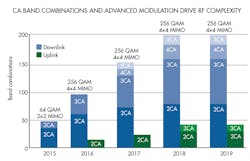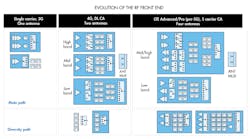What are the Top Challenges Facing Smartphone Manufacturers?
Download this article as a .PDF
Rising mobile data demand continues to create complex RF challenges for smartphone manufacturers. Globally, mobile data consumption grew 63% in 2016, and is projected to increase sevenfold by 2021, according to the Cisco Visual Networking Index.
Growth is largely being driven by video traffic, which already accounts for more than half of mobile data use, and is projected to account for more than 75% by 2021. Video consumption is also driving demand for faster networks, as well as greater network capacity. This need will become more acute as the smartphone increasingly becomes users’ primary device for streaming TV and movies, including higher-resolution 4K video. The growth of real-time video uploading, as well as new usages such as augmented and virtual reality, will drive demand for faster uplink and downlink connections.
In the long term, 5G is expected to deliver multi-gigabit data rates to the handset, but widespread 5G deployments are several years away. To support the demand in the near term, mobile network operators and handset makers are applying a combination of techniques to increase the performance of 4G networks, with a target of delivering 1 Gbps to advanced handsets (Fig. 1).
Four approaches are key to achieving this goal: advanced carrier aggregation (CA), LTE over unlicensed spectrum, higher-order modulation, and 4×4 multiple-input, multiple-output (MIMO). Each of these approaches adds RF complexity to handsets, and smartphone manufacturers will need to support all four to deliver 1-Gbps data rates. Adding to the challenges, manufacturers need to squeeze this added complexity into the relatively fixed space allocated to the RF front-end (RFFE). Power management in the RFFE is also becoming even more of a priority as manufacturers seek to maximize battery life and support a new higher-power LTE standard.
Carrier Aggregation Complexity
Today, CA is the primary method that operators are using to drive higher data rates. CA combines multiple LTE carriers (called component carriers) to increase bandwidth beyond the 20-MHz single-carrier maximum and deliver data rates greater than 150 Mbps. It also enables network operators to use their fragmented spectrum holdings more efficiently. Most operators initially implemented CA only in the downlink path, to support user demand for streaming video and other applications that primarily involve data downloads rather than uploads.
Many early implementations aggregated only two component carriers. Now, however, operators are combining three, four, or even five to further increase data rates. In general, three or more component carriers are required to provide more than 40-MHz bandwidth and deliver speeds greater than around 300 Mbps. Because of this trend, and because spectrum allocations differ in each country, there has been an extraordinary increase in the number of different band combinations that handsets must support. This drives incredible complexity in the RF pathways within the handset, particularly in premium smartphones designed for global use. Figure 2 shows how the number and complexity of CA band combinations have increased over time.
As the number of combined bands increases, so does the likelihood that some of the combined bands will share the same phone antenna. This situation creates new filtering challenges. To support simultaneous communication on multiple component carriers, the device’s RFFE must support multiple open, parallel transmit and receive paths between the transceiver and the antenna. At the same time, it must provide sufficient isolation between those paths to avoid problems (e.g., desensitizing the receiver).
Multiplexers provide a solution to this quandary. They combine all of the transmit and receive filters for multiple aggregated bands into a single component, allowing them to connect to the antenna at the same time while providing the required isolation between them. Without using a multiplexer, it may be impossible to meet system requirements for isolation between bands—and between the transmit and receive frequencies of FDD-LTE bands—together with low insertion loss and low current consumption.
However, designing multiplexers presents difficulties that increase exponentially with the number of aggregated bands, due to the growing number of potential interactions between all the filters within the multiplexer. The filters must be carefully co-designed to maintain low insertion loss and high linearity, while achieving adequate rejection of harmonics.
Considering all the possible interactions, there are eight isolations required in a quadplexer (four filters, used for aggregating two FDD-LTE bands) and 18 in a hexaplexer (six filters for three bands). For mid-band and higher frequencies, high-Q bulk acoustic wave (BAW) filters are essential to provide the steep skirts required to avoid interference between closely spaced bands, combined with low insertion loss. Figure 3 shows performance data for a Qorvo hexaplexer, illustrating the low insertion loss and rejection of adjacent bands.
For smartphone manufacturers, the choice of antenna architecture—including the number of frequency bands allocated to each antenna and the way the bands are partitioned among the antennas—will drive the decisions about the multiplexing required to support the desired CA combinations.
While early CA deployments focused on downlink, uplink CA is also being adopted as trends such as uploading real-time video gather strength. Though fewer band combinations have been defined, and are generally limited to two or three carriers, they present new and unique RF challenges. In China, intra-band uplink CA (combining carriers within the same band) is being used to overcome the uplink bandwidth limitations of TDD-LTE. The higher peak‐to‐average power ratios (PAPRs) and wider bandwidth of these signals requires highly linear power amplifiers (PAs). Envelope tracking (ET) is needed to maximize PA efficiency at high power output. Filters must also be capable of handling the higher power output. With inter-band uplink CA (combining carriers in different bands), high linearity in front-end components, such as switches, are required to avoid problematic intermodulation frequencies that can be created by interactions between signals.
Higher Frequencies and Higher-Order Modulation
Adding frequency bands, including higher-frequency LTE bands and unlicensed frequencies, is an important element of operators’ plans to increase network capacity and performance. Key technologies include Licensed Assisted Access (LAA), which uses CA to combine unlicensed 5-GHz spectrum (shared with Wi-Fi) with licensed LTE bands. Use of these higher-frequency bands for LTE will require highly linear front-end components and new filtering and multiplexing solutions.
Higher-order modulation is also being employed to squeeze higher data rates out of existing networks. For example, the increase from 64 QAM to 256 QAM in the download link provides up to 33% greater throughput. However, the higher signal-to-noise ratio needed for 256 QAM also requires higher linearity and lower insertion losses in the RFFE.
Increasing RF Front-End Integration
To achieve gigabit performance, handsets will need to support four simultaneous downlink data streams. This transition from 2×2 to 4×4 MIMO means smartphones must accommodate entire additional RF chains as well as more antennas. This will drive increasing levels of integration in the RFFE.
Today’s premium handsets already use highly integrated RFFEs. Qorvo’s RF Fusion, for instance, employs advanced packaging techniques to integrate all primary PA, filtering, and switching functionality into compact modules respectively covering low-, mid-, and high-band frequencies. The RFFE architecture is evolving to still higher levels of integration, such as the consolidation of medium and high bands into a single module (Fig. 4). This requires new higher-order multiplexers to enable aggregation of mid- and high-bands sharing the same antenna. Besides saving space, this approach eliminates the need for on-board matching between components, which may reduce losses for both the transmit and receive paths by 1.0 dB or more.
Antenna tuners will be required for each antenna. This requirement is not just to support the growing number of frequency bands, but also to optimize performance, since the continuous changes in the handset’s RF environment may affect each antenna differently.
Power Management Challenges
The growing complexity of RF pathways within the smartphone increases potential losses. Thus, it is even more difficult to achieve targets for output power at the antenna and receive sensitivity while minimizing power consumption to conserve battery life. Envelope tracking (ET) is an important technology for increasing power efficiency. To date, it has been used primarily in flagship phones, but is now spreading to mid-tier phones. ET continuously adjusts the PA supply voltage to track the RF envelope and maximize PA efficiency, thus reducing power consumption.
A different power management challenge has been created by the new LTE Power Class 2 standard, which doubles antenna output power to +26 dBm on the high-frequency Band 41. The added power compensates for the greater propagation losses at higher frequencies, allowing operators to maximize coverage with existing LTE infrastructure. Supporting Power Class 2 in handsets requires low-loss, high-linearity filters to effectively dissipate the additional heat generated at higher output power, such as BAW solidly mounted resonator (SMR) filters, along with increasingly efficient PAs meeting stringent error vector magnitude (EVM) requirements.
Supporting the Expanding Capabilities of Mid-Tier Smartphones
Fast-expanding Chinese manufacturers have been largely responsible for driving rapid growth in mid-tier smartphones within that country—the world’s largest smartphone market. Now, those manufacturers are looking to expand from China’s domestic market to selling overseas. This requires them to balance several factors. Adding RF content enables each handset model to support more bands for broader geographic use, thus minimizing the number of different models manufacturers need to produce.
On the other hand, manufacturers need to limit the component costs of each handset, since the mid-tier category is highly price-sensitive. The net result is likely to be that RFFEs designed for mid-tier smartphones, such as the Qorvo RF Flex, will become progressively more integrated while still leaving room for design flexibility.
Conclusion
The quest for gigabit speeds is creating extraordinary RF complexity in handsets. RFFEs must integrate more functions while providing very high linearity, minimizing insertion loss, and reducing power consumption. As RF complexity increases, handset manufacturers will increasingly rely on RFFE suppliers that can help solve these challenges, providing integrated solutions that meet stringent requirements.





